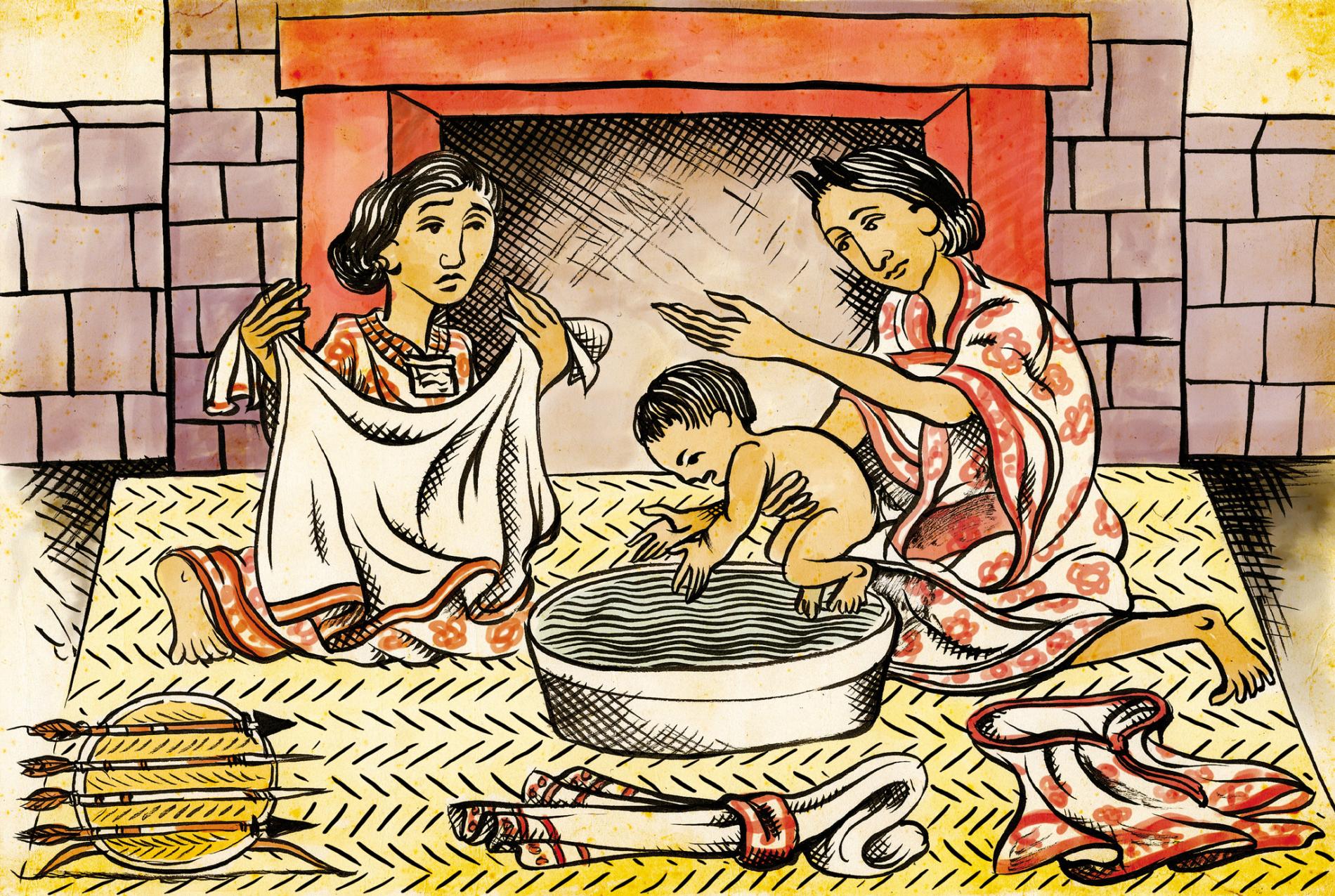Naming Ceremony
by hughpierre
Execution
- When a child is born, a soothsayer or a tonalpouhqui would consult the birth almanacs to determine the most auspicious date to initiate the child into the community. Usually the fourth day after birth.
- The tlamatlquiticitl carried the babe to a pottery vessel filled with water and surrounded by two sets of symbolic objects.
- The midwife performed four rituals with the water:
- She invoked the goddess of water and put drops of water on the baby's mouth, telling it to receive the water it needs to live upon the earth
- She touched the baby's chest with her wet hand and invoked the purifying property of water that cleans the heart
- She cast drops of water on the baby's head, telling the baby to let the water enter its body to dwell there
- Finally, the midwife washed the child's body to keep evil away from it.
- Depending on the gender, either:
- If it was a boy, the child was presented to the sky four times, calling on the sun and astral gods, that he become a warrior.
- If is was a girl, the midwife spoke to the cradle asking the protection from the mother goddess.
- From here the official name would be announced and formally recorded.
- The unbilical cord from the birth is buried in a location that coincides with a child's sex.
- A girl's umbilical cord would be buried beneath the home, even if atop a chinampas, to assure she would stay in the home to do chores rather than going outside
- a boy's would be buried on a battlefield to assure that he would become a great warrior. This can either be done by a relative or a warrior petitioned to do so on the family's behalf, who had 20 days to do so before the rituals surrounding a birth were over.
Components and tools
A religious book containing all the combinations of calendar names that is commonly referenced during the naming ceremony.
The sacred calendar shows the delicate equilibrium between the gods and is used for divination within the priesthood.
Participants
Tlamatlquiticitl
The mid-wife takes charge of the naming ceremony -when it came time for it- as the chief facilitator, offered rearing advice, oversaw medical care and ensured pre and post birth rituals. She greeted the newly delivered child as "the little captive", with war-cries and praising the panting mother for her warrior’s courage.When the pregnant one already became aware of labor pains, it was said her moment of death had come to pass...
…and when the baby had arrived on earth, then the midwife shouted; she gave war cries, which meant that the woman had fought a good battle, had become a brave warrior, had taken a captive, had captured a baby.
Parents
If there is a four day wait before the naming ceremony is to begin, the household would maintain the fires in until midwife deem otherwise. The father would also notify a priest to predict the fate of his child based on the birth date. If it was not to his liking, then he could convince or bribe a more fortuitous date. After the birth, the mother was allowed time to readjust. After which, the couple would receive her relatives and neighbours who rub ashes on their own knees and elbows to "prevent lameness and aching in the baby".New Born
During the naming ceremony, symbols of a certain profession are given to the infant. Miniature weapons such as shields, arrows, tools for wood, feather or metal work, and a scribe's implements are given to baby boys; and mini brooms, baskets and spindles to baby girls. These miniatures are shown to infants and explained to them, in order to prepare the child for their future duties. Then a baby is given a name derived from both the calendar and a personal chosen by the parents.Boys are traditionally named after animals or any names that described them, such as Hungry Turkey, Fire Coyote or He Who Laughs At Women.
Girl names are usually represented by a flower or something feminine such as Jade Doll or Precious Broken Plume.
The children would carry these names for protection during their most formative year until their seventh birthday, when they choose their adult names. The naming ceremony ends with grim speeches of the honest hardships of life, wishes for the child to be great and long life despite life's cruelties.




Nice article. Little details on umbilical cord under the house so that daughters don't leave. Warriors being petitioned to carry a bag of cords from boys to a battlefield. Good stuff on the culture.